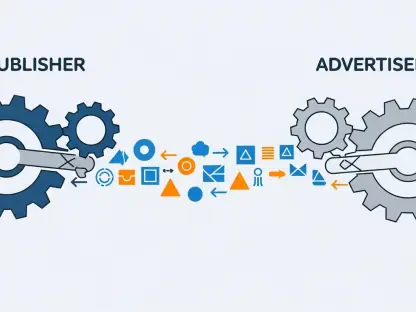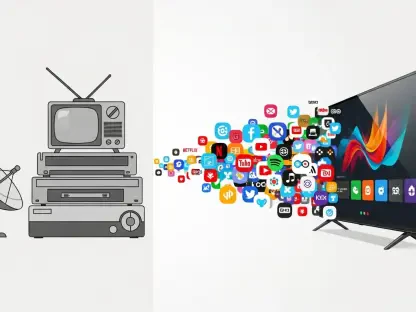What happens when the lifeline of digital connectivity becomes a luxury for millions in one of the world’s largest telecom markets? In India, where mobile data has transformed lives by bridging urban and rural divides, recent moves by industry giants Reliance Jio and Bharti Airtel to scrap their cheapest prepaid plans have ignited a firestorm. As tariffs creep upward, the stark reality for low-income users emerges: staying connected might now mean sacrificing other essentials. This shift raises a critical question about the balance between corporate profit and social equity in a nation racing toward digital dominance.
The stakes couldn’t be higher in a country where over a billion people rely on affordable telecom services for everything from education to financial transactions. The decision by Jio and Airtel to discontinue entry-level plans affects an estimated 20-25% of Jio’s subscribers and 18-20% of Airtel’s user base, many of whom are daily wage earners or rural residents. With mobile connectivity serving as the backbone of India’s digital revolution, this trend threatens to widen the digital divide, pushing regulators and companies into a tense standoff over accessibility versus profitability.
A Telecom Tug-of-War: Profit or Accessibility?
The Indian telecom landscape has long been a battleground of aggressive pricing and mass outreach, with Jio and Airtel leading the charge. Their initial strategy of rock-bottom tariffs fueled unprecedented growth, bringing internet access to remote corners of the country. However, the recent shift to eliminate the most affordable plans signals a pivot toward financial gains, as both companies aim to bolster their bottom lines in a competitive market.
This tension between profit motives and accessibility has sparked widespread debate. Jio has halted online sales of its INR 249 ($2.82) plan, though it remains available offline, while Airtel has entirely eliminated its basic offering. In their place, pricier plans starting at INR 299 ($3.38) for 28 days have emerged, a jump that may seem small but looms large for users scraping by on minimal budgets. The question remains whether this move prioritizes shareholder value over the needs of the masses who built these companies’ success.
The Backbone of India’s Digital Revolution
Beyond mere numbers, the telecom sector in India represents a transformative force, connecting diverse populations and powering economic growth. Affordable plans once enabled everyone, from city dwellers to village farmers, to access online education, mobile banking, and government programs. This democratization of data has been pivotal in narrowing socio-economic gaps, making connectivity not just a convenience but a necessity.
Now, with budget-friendly options vanishing, the risk of exclusion looms large. Low-income households, already strained by economic challenges, face the prospect of losing access to critical digital tools. Reports indicate that many users may have to ration data usage or forgo services altogether, potentially stalling progress in areas like rural development and financial inclusion, where mobile networks play a vital role.
Decoding the Tariff Hike: Strategy, Data, and Impact
A closer look at the tariff revisions reveals a calculated strategy by Jio and Airtel. Both companies have introduced higher-tier plans—Jio offering 1.5GB of daily data and Airtel providing 1GB daily, each at INR 299 ($3.38) for 28 days. They justify this by pointing to a surge in data consumption since the 5G rollout, arguing that users now demand more robust packages. Yet, the absence of widespread, compelling 5G applications beyond fixed wireless access casts doubt on whether this shift truly reflects consumer needs or corporate agendas.
Financial incentives are also at play, with a clear focus on boosting Average Revenue Per User (ARPU). From 2025 onward, Jio’s ARPU is projected to rise by an additional INR 11-13 ($0.12-$0.14) per month, while Airtel could see gains of INR 10-11 ($0.11-$0.12), as subscribers migrate to costlier plans. This push aligns with broader industry trends, including heavy investments in 5G infrastructure and the need for sustainable revenue streams, especially as Jio gears up for a major IPO in 2026.
The ripple effects are significant. Over the past two years, multiple tariff hikes have mirrored the high costs of network upgrades, yet monetization challenges persist. For struggling competitors like Vodafone Idea, industry-wide price increases offer a lifeline to stabilize finances, but for consumers at the lower end of the spectrum, these changes translate to tougher choices about staying connected.
Voices of Concern: Profit Versus Social Responsibility
Regulatory bodies have not remained silent amid this pricing upheaval. The Telecom Regulatory Authority of India (TRAI) has repeatedly emphasized that accessible communication is non-negotiable for millions who depend on mobile data for survival. A senior TRAI official recently stated, “Affordability must remain a cornerstone, even as companies chase revenue growth,” highlighting the urgency of protecting vulnerable users.
On the other side, telecom operators defend their decisions with a focus on sustainability. A Jio representative argued, “The evolving needs of users require plans that match current data demands while ensuring long-term business viability.” Airtel has echoed similar sentiments, stressing the need to balance innovation with profitability. However, these corporate perspectives often clash with the ground realities faced by subscribers.
The human toll is evident in stories from affected individuals. Consider Sunita, a vegetable vendor from Bihar, who relied on a basic plan to coordinate with suppliers and customers. “With the cheapest option gone, I can barely afford to recharge,” she lamented. “Now, I miss orders and lose income.” Such personal accounts, coupled with TRAI data showing persistent digital inclusion gaps, underscore the social cost of prioritizing profit over people.
Bridging the Divide: Solutions for Users and Regulators
For low-income users caught in this pricing crunch, immediate workarounds are essential. Those near Jio outlets can still access the INR 249 plan offline, while others might pool resources with family to opt for higher-tier plans at shared costs. Additionally, tapping into government-subsidized connectivity programs or public Wi-Fi initiatives in rural zones could offer temporary relief from rising expenses.
Regulators and telecoms also have a role to play in crafting long-term solutions. TRAI could advocate for mandatory low-cost plans with basic data and call benefits to ensure no one is left offline. Meanwhile, Jio and Airtel might explore tiered pricing structures that allow gradual upgrades without alienating budget-conscious subscribers or roll out limited-time discounts tied to 5G adoption to soften the transition for users.
Broader systemic efforts are equally critical. Consumer advocacy groups can amplify the concerns of marginalized users, pushing for policies that balance corporate interests with social equity. Encouraging competition by supporting smaller operators could also help keep tariffs in check, ensuring a diverse range of options for all income brackets. Collaborative dialogue between stakeholders remains key to preventing a deeper digital divide.
As the debate over telecom tariffs unfolds, it becomes clear that the clash between profitability and accessibility has left an indelible mark on India’s digital landscape. Reflecting on the challenges faced by low-income users, the path forward demands innovative approaches to ensure connectivity for all. Policymakers need to prioritize frameworks that compel companies to retain affordable plans, while telecom giants must rethink strategies that don’t exclude their most vulnerable customers. Only through such concerted efforts can the promise of a truly inclusive digital India be realized, safeguarding access as a right rather than a privilege.









